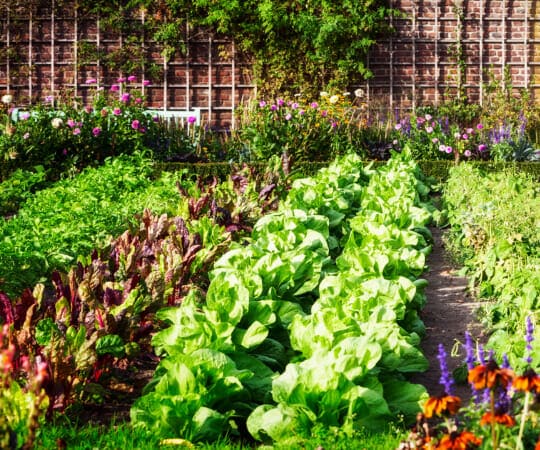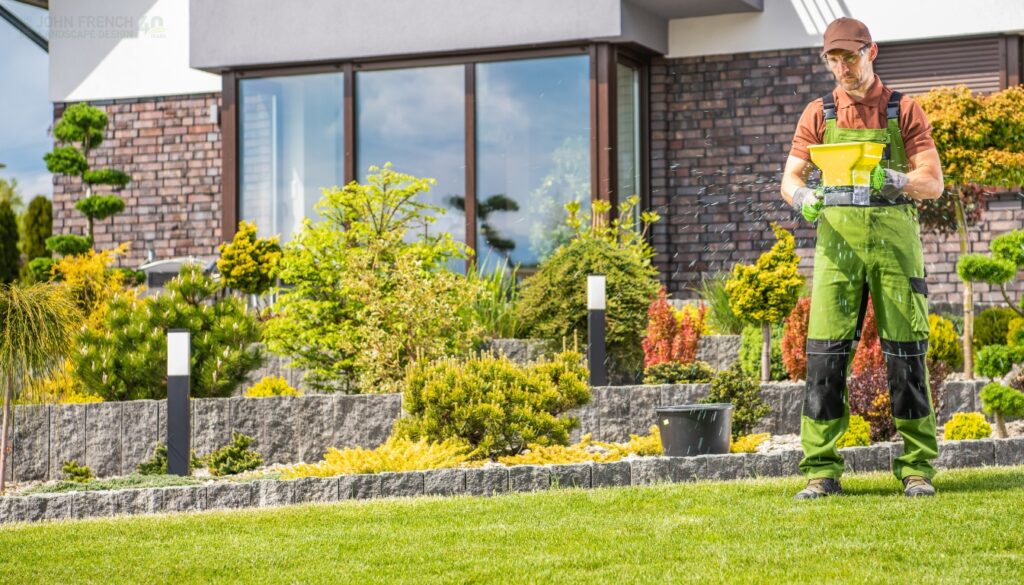Sow, Grow, and Feast: Cultivate an Edible Oasis in Your Garden and Reap the Delicious Rewards
Are you tired of buying produce that lacks flavor and nutrition from the grocery store? Why not take matters into your own hands and grow your own fruits and vegetables in your backyard?
Not only is it a rewarding experience, but it also provides numerous benefits for both you and the environment.
Growing your own produce allows you to control what goes into your food, avoiding harmful pesticides and chemicals. Plus, nothing beats the taste of freshly picked fruits and vegetables straight from your garden.
In addition to providing delicious meals for you and your family, gardening also promotes physical activity and can reduce stress levels. So why not turn your backyard into an edible paradise and savor the fruits of your labor?
Benefits of Growing Your Own Produce
You’ll be amazed at how much more delicious and satisfying your meals will become when you start incorporating fresh, homegrown produce into them. Not only do fruits and vegetables from your own garden taste better than store-bought ones, but they also have numerous health benefits.
When you grow your own produce, you have control over what chemicals are used in the growing process, so you can avoid harmful pesticides and herbicides that are often used in commercial farming.
In addition to being healthier for you, growing your own produce can also save you money in the long run. While there may be initial costs associated with setting up a garden, such as purchasing seeds or plants and soil amendments, the cost savings of not having to buy expensive organic fruits and veggies from the grocery store can add up quickly.
By investing a little bit of time and effort upfront, you can reap the rewards of a bountiful harvest for years to come. And it all starts with choosing the right location…
Choosing the Right Location
Just like how a seed needs the right environment to grow and thrive, selecting the ideal spot for your future harvest is crucial to ensuring success in creating a bountiful garden. When choosing the location for your edible paradise, consider the following:
- Soil quality: The soil is where everything begins and ends when it comes to gardening. Make sure that your chosen spot has healthy soil that’s free from contaminants and has good drainage. You can also test the pH level of your soil using a kit bought from any gardening store.
- Microclimates: Different areas within your yard can have varying microclimates depending on factors such as sun exposure, wind patterns, and even nearby structures like buildings or trees. Take note of these microclimates because they can affect what plants will thrive in certain areas.
- Space: Make sure you have enough space for all the plants you want to grow! Some vegetables need more room than others so plan accordingly.
It’s important to choose wisely because once you start planting, it’s difficult to move things around without disturbing the root systems of established plants or damaging delicate seedlings. With careful consideration of these factors, you’ll be well on your way towards creating an optimal growing environment for your garden-to-table journey!
As you continue on this journey towards cultivating your own edible paradise, it’s time to start preparing your garden!

Preparing Your Garden
Get ready to roll up your sleeves and start prepping for a successful harvest by taking the necessary steps to prepare the soil, gather materials, and plan out your garden layout.
Soil preparation is one of the most important steps in cultivating a thriving garden. Begin by testing your soil’s pH levels to determine what type of amendments it needs. If your soil’s too acidic, add lime; if it’s too alkaline, use sulfur. Next, loosen the soil with a tiller or hoe and mix in compost or other organic matter to provide nutrients for your plants.
Seed selection is another crucial factor in having a bountiful garden. Choose seeds that are appropriate for your climate zone and growing season length, as well as those that’ll thrive in the amount of sunlight you have available. Make sure to read seed packets carefully for information on planting depth and spacing requirements.
With proper soil preparation and seed selection, you’ll be well on your way to a healthy garden full of fresh produce.
Now that you’ve prepared your garden space and selected high-quality seeds, it’s time to move onto maintaining and harvesting your garden without missing any crucial step!
Maintaining and Harvesting Your Garden
As you continue to tend to the fruits of your labor, think of yourself as a wise and experienced farmer, carefully nurturing your crops so that they may grow strong and plentiful.
A key aspect of maintaining a healthy garden is through proper composting techniques. Composting enriches the soil with nutrients, improves drainage, and helps retain moisture levels. Start by collecting kitchen scraps such as fruit peels, coffee grounds, and eggshells in a designated container. Add brown materials like leaves and shredded paper for balance and mix until well combined. Place the mixture in a compost bin or pile and stir occasionally for optimal decomposition.
Another important aspect of maintaining your garden is pest control techniques. Instead of using harsh chemicals that can harm both pests and beneficial insects alike, try natural methods like companion planting or introducing insect-repelling plants like marigolds or lavender into your garden bed. You can also handpick insects off plants or use organic pest control sprays made from essential oils like neem or peppermint oil.
Now that you’ve learned about how to maintain and harvest your garden successfully, let’s move on to enjoying the fruits (and vegetables) of your labor without delay!
Enjoying Your Fruits and Vegetables
Now that you’ve harvested your fresh produce, it’s time to start enjoying the fruits of your labor! Cooking and preserving your vegetables is a great way to extend their shelf life and add some variety to your meals.
Don’t forget to share your bounty with friends and family – there’s nothing quite like the satisfaction of seeing others enjoy the food you’ve grown. And remember, by continuing the cycle of ‘from garden to table’, you’re not only nourishing yourself, but also contributing to a more sustainable future.
Cooking and Preserving
Cooking and preserving your homegrown produce adds a personal touch to meals and allows you to enjoy the flavors of nature all year long.
There are many cooking techniques you can use to bring out the best in your fruits and vegetables. For example, grilling or roasting can caramelize sugars in root vegetables like sweet potatoes, while steaming or stir-frying can preserve the delicate flavor of leafy greens like spinach.
When it comes to storage options, there are various methods you can use depending on the type of produce you have. Root vegetables like carrots and beets should be stored in a cool, dry place such as a cellar or refrigerator crisper drawer. Fruits that ripen quickly such as tomatoes and berries should be eaten within a few days or frozen for later use.
Preserving your harvest is also an excellent way to ensure that nothing goes to waste. You can make jams, pickles, and chutneys from excess fruits and veggies which will help extend their shelf life even further. Canning is another popular method for preserving produce such as tomatoes or green beans which can then be enjoyed throughout the winter months when fresh produce may not be readily available.
By using these preservation techniques, you’ll have access to delicious homegrown food all year long! And now that you’ve learned how to cook and preserve your bounty, let’s talk about sharing with friends and family – because what’s good is not shared?
Sharing with Friends and Family
You can’t keep all this deliciousness to yourself – it’s time to spread the love and share the bounty with your friends and family!
Hosting parties is a great way to showcase your homegrown produce. You could host a BBQ and feature fresh vegetables as sides or grill them up for kabobs. Or, you could throw a garden party complete with fresh herbs in cocktails and appetizers made from your harvest. Not only will your guests be impressed by the taste, but they’ll also appreciate the effort you put into growing your own food.
Another way to share your garden’s bounty is through gift ideas. Consider gifting homemade jams or pickles made from surplus produce, or create herb-infused oils and vinegars for cooking enthusiasts. For those who enjoy baking, hand-picked berries or fruits make for excellent pies and muffins. Your loved ones will appreciate not only the thoughtfulness of these gifts but also the unique flavor that comes from using freshly grown ingredients.
As you continue to share your garden’s bounty with others, you are continuing the cycle of ‘from garden to table’. The joy of growing, harvesting, cooking, preserving, and sharing creates a sense of community around food that can’t be replicated elsewhere.
So keep cultivating an edible paradise and savoring the fruits of your labor – not just for yourself but for those around you too!
Continuing the Cycle of ‘From Garden to Table
By sharing your homegrown produce with others, you’re not only creating a sense of community around food but also continuing the cycle of growing, harvesting, and preserving for future enjoyment.
Once you’ve harvested your crops, consider composting any leftover plant matter to nourish your soil for next season’s planting. Composting is a simple process that involves layering green (nitrogen-rich) materials like vegetable scraps and grass clippings with brown (carbon-rich) materials like fall leaves and shredded newspaper. With time and moisture, these materials will break down into rich, dark compost that can be used as a natural fertilizer.
To continue the cycle from garden to table, it’s important to plan ahead for seasonal planting strategies. Depending on where you live, there may be certain times of year when it’s best to plant specific crops. Research which plants grow well in your region during different seasons and plan accordingly.
You can also extend your growing season by using techniques such as cold frames or row covers to protect tender plants from frost. By staying mindful of the changing seasons and adjusting your gardening practices accordingly, you’ll be able to enjoy fresh produce from your own backyard all year round.

Frequently Asked Questions
Are there any specific fruits or vegetables that are easier to grow than others?
If you’re new to container gardening, there are definitely some crops that are easier to grow than others. A great place to start is with herbs like basil, chives, and mint. These plants tend to be forgiving if you forget to water them or give them too much sun.
Another beginner-friendly crop is salad greens like lettuce and arugula. They don’t require a lot of space and can be harvested multiple times throughout the growing season.
Tomatoes can also do well in containers, just make sure they have enough support as they grow taller. Overall, starting with these easy-to-grow crops will help build your confidence as a gardener and lead to delicious fruits and vegetables for your table!
How can you prevent pests and diseases from damaging your garden?
Preventing pests and diseases from damaging your garden can feel daunting, but there are natural remedies you can use to keep your plants healthy.
Companion planting is an effective way to deter pests. For example, planting marigolds with tomatoes can repel nematodes and aphids.
Using natural solutions like neem oil or garlic spray can help control insect infestations without harmful chemicals.
Regularly inspecting your plants for signs of disease and promptly removing any infected leaves or fruits can also prevent the spread of illness throughout your garden.
By implementing these practices, you’ll be well on your way to maintaining a thriving and bountiful garden.
What are some creative ways to use excess produce from your garden?
Got too much produce from your garden? Don’t let it go to waste!
Get creative with preservation methods and sharing with others. Creative preservation can range from pickling vegetables to making jams and jellies. You can also freeze excess fruits and veggies for later use in smoothies or soups.
Another great way to avoid waste is by sharing your bounty with friends, family, and even local food banks. Not only will you feel good about reducing food waste, but you’ll also be able to share the delicious flavors of your homegrown produce with others.
So, get creative and share the love!
Is it possible to grow produce in containers or small spaces?
Looking to grow your own produce, but don’t have a lot of space? Fear not!
With vertical gardening and hydroponic systems, you can cultivate an edible paradise even in small areas. Vertical gardening allows you to utilize vertical space by growing plants upwards on walls or trellises. Hydroponics involves growing plants in water instead of soil, allowing for efficient use of space and resources.
Both methods are great options for those with limited outdoor space or who want to grow produce indoors. Plus, the satisfaction of harvesting your own fresh fruits and veggies is truly unbeatable!
How do you know when it’s the right time to harvest your fruits and vegetables?
When it comes to harvesting your fruits and vegetables, there are a few key things to keep in mind. First and foremost, pay attention to the ripeness indicators specific to each type of produce.
For example, with tomatoes, look for a rich red color and firmness when gently squeezed. With cucumbers, check for a deep green color and crisp texture. Harvesting at the right time ensures maximum flavor and nutrition.
Once you’ve picked your produce, it’s important to store and preserve it properly. This includes washing thoroughly before storing in a cool, dry place or preserving through canning or freezing techniques.
By following these harvesting tips and maximizing yield through proper storage techniques, you’ll be able to enjoy the fruits (and veggies) of your labor all year long!
Conclusion
Congratulations! You’re on your way to cultivating an edible paradise and savoring the fruits of your labor. By growing your own produce, you not only save money but also ensure that you’re eating fresh and healthy food.
Did you know that homegrown vegetables contain up to 40% more nutrients than store-bought ones? Now that you’ve learned how to choose the right location, prepare and maintain your garden, it’s time to enjoy the fruits of your labor.
Whether it’s a fresh salad or a hearty stew made with your very own vegetables, nothing beats the taste of homegrown produce. And don’t forget about those delicious fruit trees! Imagine picking ripe peaches from your very own tree for a summertime treat.
By following these simple steps, you can create an oasis in your backyard and enjoy the many benefits of growing your own produce. Remember to keep experimenting with different varieties and techniques until you find what works best for you.
Happy gardening!
Related Sources



